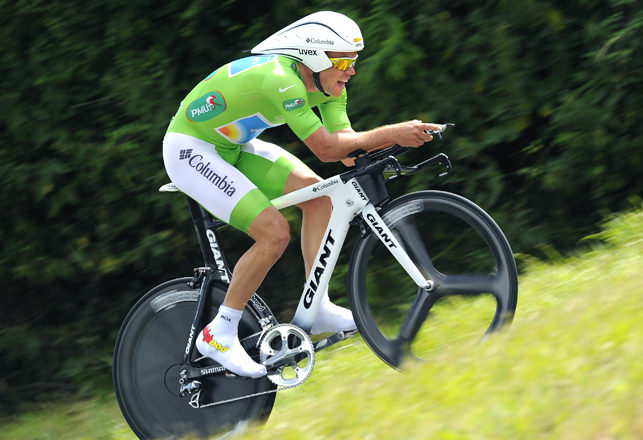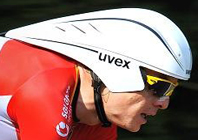In the 2008 Tour de France, much to the surprise of many experienced veterans of this world-famous endurance cycling road race, Team Columbia took second and third places in the time trials, winning the overall team prize in the first of the trials at Cholet.
Riding bikes from Taiwan’s Giant, the world’s largest cycle manufacturer, Columbia beat most of the time trial specialists with its team of non-specialist riders. And as if that wasn’t enough to make people sit up and take notice, the same bike was used by the team’s Bert Grabsch a couple of weeks earlier to win the individual time trial in the 2008 World Championships.

Kim Kirchen of Team Columbia riding to second place in the fourth stage of the 2008 Tour de France on the bike designed for Giant by Velo Science. (Copyright: Tim de Waele)
These two events put Giant firmly in the driving seat – or rider’s saddle – of cycle road racing.
Giant’s secret weapon for Team Columbia was a brand new bike, the frame and handlebars for which were designed and produced in just two months by UK-based design engineering consulting firm, Velo Science.
As a result of these successes for Giant in 2008, Velo Science was asked by another well-known sporting goods manufacturer to design a bike for the 2009 Tour de France, while other work both in the cycling world and in other industries is also flowing in.
Founded in 2007 by Simon Smart, a keen cyclist and an aerodynamicist who had spent the previous 15 years working in top-level motor-sport, culminating in his appointment as aerodynamicist/team leader at the Red Bull Racing Formula 1 team, Velo Science is an engineering design consulting firm. It offers design, engineering, aerodynamics and product development services to the bike industry, as well as to other industries, including motor-sport. It also offers wind tunnel test services under the name of Drag2Zero.
While Giant’s secret weapon in the 2008 Tour de France was a brand new bike, Velo Science has a not-so-secret weapon of its own to bring to bear on its clients’ design engineering projects: Smart’s experience of Formula 1’s experimental yet pragmatic approach to rapid product development, combined with the use of Siemens PLM Software’s NX Mach 3 product design software.
“We selected NX Mach 3 rather than any of the other systems we evaluated because the people we were dealing with at Siemens’ leading business partner for the UK, Majenta PLM, showed that they understood what we were trying to do and also helped us appreciate that the capabilities of NX extend well beyond straightforward design and modelling,” explains Smart. “And they have been very supportive to us ever since,” he adds.
Pushing the envelope
In designing race-winning bikes for its clients, Velo Science has to consider all the aerodynamic aspects of the bike and rider together, including the rider’s position as well as the frontal area of the bike itself, in order to reduce drag to a minimum.
When around 90% of a rider’s power output is consumed by aerodynamic drag, with some 60-70% of that consumption coming from the rider and 30% from the bike, reducing this aerodynamic drag is where the majority of improvement in speed is to be found.
As Smart explains, “The power a rider produces is well understood and measurable to a few percent. A top rider will produce around 400 watts of power, which is equivalent to about 0.5 hp. More power equals more speed. However, even if he trains harder than he already trains, he will only add maybe 10-15 watts of additional power. On top of that, the weight of racing bikes is already down to around 5-6 kg. So the best way of improving speed is to reduce the aerodynamic drag of the rider and bike.”
The two major design challenges faced by Velo Science when designing a bike are therefore achieving stiffness and weight targets – which tend to conflict with each other – and reducing aerodynamic drag.
In addition though, they must consider the needs of the race mechanics to be able to work quickly and easily on the bikes during a race. And last, but by no means least, they must consider its suitability for being mass produced later for sale around the world, to satisfy the rules of cycle racing’s governing body. From that standpoint it is a much greater challenge, in Smart’s view, than designing a Formula 1 car which will only ever be produced in very limited quantities, of three or maybe four.
It’s in meeting these challenges that the use of NX Mach 3 has an important role to play. Part of the NX Mach Series range of mechanical design solutions, NX Mach 3 brings together one integrated software environment for solid modelling, advanced freeform modelling and surface analysis, detail drafting, design review, validation and optimisation, stress and vibration analysis, rapid prototyping, advanced assembly design and engineering process management.
Within this comprehensive range of design and modelling facilities there are several specific capabilities that Velo Science finds particularly helpful in getting to the point at which something can be physically produced.
While NX offers a combination of parametric feature-based, explicit and direct geometric design modelling tools, Smart and his team tend to work in parametric mode as he finds that it helps the design flow.
Powerful Design Assistants
The process that Smart tends to go through starts with his putting together a scheme which has the bike’s layout contained in a single file in the form of sketches and basic curves. When that’s ready he then begins modelling the individual parts and builds up an assembly part by part using the assembly modelling functions of NX. These enable rapid navigation of the assembly hierarchy and allow direct access to the design model of any component or sub-assembly. They also enable the creation of parametric assemblies which capture and preserve the design intent whenever changes are made.
“NX supports both top-down and bottom-up assembly modelling,” explains Smart. “I tend to think about the design from the top down but work on it from the bottom up as I find this quite an intuitive way to work.”
With the goal that Smart is working to being an aerodynamically sound model that can be tested and proved in a wind tunnel, the surface modelling tools provided by NX are an important part of the design process. So are some of the specialized tools that might be termed ‘design assistants’, such as the Sketcher, DesignLogic and the Optimisation Wizard. “The Sketcher is a great tool and a real help to productivity”, states Smart.
He uses it to start the modelling process by laying down basic curves and shapes, just as one would with a pencil or brush and then goes on to refine certain aspects of the design, such as spline curves for example, with more accuracy by defining their end conditions and curvature and tangency using the advanced free-form modelling tools in NX.
Another of the design assistants that Smart finds useful during this modelling process is a tool called DesignLogic. This enables design intent or knowledge to be incorporated into a design, on-the-fly, allowing rich control of design parameters both at creation time and during subsequent editing. At Velo Science it is used, for example, to generate aerodynamic curves using the tool’s embedded formulae and expressions to set the parameters of the curves, thereby saving Smart time looking for and using a calculator.
Once the basic model has been arrived at and with a good idea of the flow conditions that will obtain, third-party Computational Fluid Dynamics (CFD) software is used to analyse simulated air-flows over the model. The results are used to fine tune the model accordingly before it is then analysed for curvature and surface continuity using the face analysis tools in NX. These provide real-time graphical feedback that helps in the analytical and visual evaluation of surface quality, including the highest quality type of surface, the Class A surface used in the automotive industry.
Nevertheless, with one of the main design challenges faced by Velo Science being the need to combine optimum stiffness with minimum weight for a bike frame, Finite Element Analysis (FEA) is an important aspect of the design process. As Smart explains, “There is little point in designing something that works fine under CFD analysis but then fails structurally”.
So another of the specialised tools in NX is used to simulate the bending and flexing of a bike frame, for example, to see where the stresses occur on the model and as a relatively quick and simple way of arriving at a model that will work properly under full analysis by FEA specialists.
Closing the loop
Eventually, with a virtual model that appears –at least theoretically – to perform to the required performance targets in terms of stiffness, weight and aerodynamic efficiency, NX is used to produce a .STL (stereolithography) file for use in the rapid prototyping (RP) production of a part for wind tunnel testing. Alternatively, an IGES file is produced so that the part can be machined from metal by Velo Science’s parts supplier. The choice of which route is taken is a trade-off between the speed of RP and the superior surface finish of an NC machined part.
It’s then an iterative process involving wind tunnel testing, using the test measurements – drag, lift, moment forces, etc. – to modify the model and then retesting, with the number of iterations being reduced to the minimum by running CFD analysis and wind tunnel testing in parallel whenever possible. The final model is then saved for use in the design of the mould tools that will be used in manufacturing the bike.
The end result of this process in the case of Giant was a bike that surprised the world of cycle road racing, the frame and handlebars for which were delivered just two months after Velo Science was asked to design them.
“Without NX we would probably need to add another 50% onto the time it takes to develop a design that’s ready for wind tunnel testing,” says Smart. “There are only four of us in the company but by using NX we can meet our clients’ demanding time schedules and still have confidence in the end results,” he adds.
That means that cycle racing is probably going to become even more competitive in the future as the skills and expertise of Simon Smart and his team at Velo Science, together with their use of NX Mach Series, become even more in demand by bike manufacturers around the world.
www.veloscience.co.uk / www.majentaplm.com

NX gives Velo Science the winning edge in racing bike design






